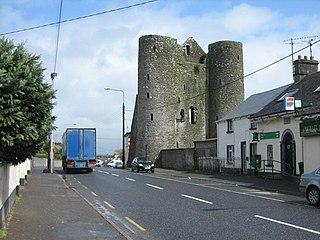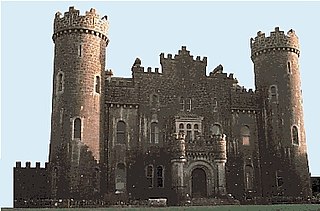
Baron Talbot of Malahide is a title that has been created twice for members of the same family—in 1831 in the Peerage of Ireland as Baron Talbot of Malahide, and in 1856 in the Peerage of the United Kingdom as Baron Talbot de Malahide. While the barony of 1856 became extinct in 1973, the barony of 1831 is extant. Until 1976, the ancestral seat of the family was Malahide Castle, close to the village of that name, north of Dublin, Ireland.

Delvin is a village in County Westmeath, Ireland; it is located on the N52 road at a junction with the N51 to Navan. The town is 20 km (12 mi) from Mullingar.

Powderham Castle is a fortified manor house in Exminster, Devon, 6 miles (9.7 km) south of Exeter and 1⁄4 mile (0.4 km) north-east of the village of Kenton, where the main public entrance gates are located. It is a Grade I listed building. The park and gardens are Grade II* listed in the National Register of Historic Parks and Gardens.

Tullynally Castle, also known as Pakenham Hall, is a country house situated some 2 km from Castlepollard on the Coole village road in County Westmeath, Ireland. The Gothic-style building has over 120 rooms and has been home to the Pakenham family for over 350 years.

Stowe House is a grade I listed country house in Stowe, Buckinghamshire, England. It is the home of the private Stowe School and is owned by the Stowe House Preservation Trust. Over the years, it has been restored and maintained as one of the finest country houses in the UK. Stowe House is regularly open to the public.

Knockdrin is a townland and electoral division that is 5.6 kilometers northeast of Mullingar, in County Westmeath, Ireland. It is the home of the Westmeath Hunt, and its most notable building is Knockdrin Castle. The R394 regional road, the main Mullingar to Castlepollard route, runs through the area.

Clonyn Castle also known as Delvin Castle, is a Victorian country house situated in Delvin, County Westmeath, Ireland some 18 km from Mullingar along the N52. It is a square, symmetrical, two-storey castle-like building of cut limestone with four tall, round corner towers at each corner. The interior has a large two-storey hall with a gallery and arcading. It was one of the last Victorian baronial castles to be built in Ireland.

Sir Nugent Talbot Everard, 1st Baronet was an Irish senator nominated to the 1922 Seanad Éireann.

Killua Castle, and the nearby Raleigh Obelisk, are situated near Clonmellon, County Westmeath, Ireland. The present house was built in about 1780 by Sir Benjamin Chapman and consisted of a hall, dining room, oval drawing room, breakfast parlour and front and back stairs. There was also a stable yard, barn and haggard. From here, the Chapmans administered the surrounding farm lands of some 9,000 acres (36 km2) in the 18th century. In a ruinous condition, it was renovated in 2006.
The High Sheriff of Westmeath was the British Crown's judicial representative in County Westmeath, Ireland from its creation under The Counties of Meath and Westmeath Act 1543 until 1922, when the office was abolished in the new Free State and replaced by the office of Westmeath County Sheriff. The sheriff had judicial, electoral, ceremonial and administrative functions and executed High Court Writs. In 1908, an Order in Council made the Lord-Lieutenant the Sovereign's prime representative in a county and reduced the High Sheriff's precedence. However the sheriff retained his responsibilities for the preservation of law and order in the county. The usual procedure for appointing the sheriff from 1660 onwards was that three persons were nominated at the beginning of each year from the county and the Lord Lieutenant then appointed his choice as High Sheriff for the remainder of the year. Often the other nominees were appointed as under-sheriffs. Sometimes a sheriff did not fulfil his entire term through death or other event and another sheriff was then appointed for the remainder of the year. The dates given hereunder are the dates of appointment. The following is an incomplete list: all addresses are in County Westmeath unless stated otherwise.

Andreas Graf O'Reilly von Ballinlough was an Irish-Austrian soldier and military commander of Irish origin. His military service extended through the Seven Years' War, War of the Bavarian Succession, Austro-Turkish War, French Revolutionary Wars, and Napoleonic Wars. He retired from the army in 1810 and died at age 89.
The High Sheriff of Cavan was the British Crown's judicial representative in County Cavan, Ireland from the 16th century until 1922, when the office was abolished in the new Free State and replaced by the office of Cavan County Sheriff. The sheriff had judicial, electoral, ceremonial and administrative functions and executed High Court Writs. In 1908, an Order in Council made the Lord-Lieutenant the Sovereign's prime representative in a county and reduced the High Sheriff's precedence. However the sheriff retained his responsibilities for the preservation of law and order in the county. The usual procedure for appointing the sheriff from 1660 onwards was that three persons were nominated at the beginning of each year from the county and the Lord Lieutenant then appointed one of the nominees as his choice of High Sheriff for the remainder of the year. Often the other nominees were appointed as under-sheriffs. Sometimes a sheriff did not fulfil his entire term through death or other event and another sheriff was then appointed for the remainder of the year. The dates given hereunder are the dates of appointment. All addresses are in County Cavan unless stated otherwise.
The High Sheriff of Longford was the British Crown's judicial representative in County Longford, Ireland from the 16th century until 1922, when the office was abolished in the new Free State and replaced by the office of Longford County Sheriff. The sheriff had judicial, electoral, ceremonial and administrative functions and executed High Court Writs. In 1908, an Order in Council made the Lord-Lieutenant the Sovereign's prime representative in a county and reduced the High Sheriff's precedence. However the sheriff retained his responsibilities for the preservation of law and order in the county. The usual procedure for appointing the sheriff from 1660 onwards was that three persons were nominated at the beginning of each year from the county and the Lord Lieutenant then appointed his choice as High Sheriff for the remainder of the year. Often the other nominees were appointed as under-sheriffs. Sometimes a sheriff did not fulfil his entire term through death or other event and another sheriff was then appointed for the remainder of the year. The dates given hereunder are the dates of appointment. All addresses are in County Longford unless stated otherwise.
Richard Nugent, 2nd Earl of Westmeath was an Irish nobleman.
Thomas Nugent, 4th Earl of Westmeath was an Irish soldier and peer. He was the second son of Christopher Nugent, Lord Delvin and Mary Butler, daughter of Colonel Richard Butler. He was likely the resident of Coolamber Hall House.

Richard Wogan Talbot, 2nd Baron Talbot of Malahide, PC was an Anglo-Irish politician.

The Battle of the Big Cross was a military engagement of the Irish Rebellion of 1798 between a force of United Irishmen rebels and a column of government troops. It was fought on 19 June 1798 on a spot on the Shannonvale-Ballinascarty road known locally as the "Big Cross", approximately four miles east of Clonakilty in West Cork. It was the only battle fought in the rebellion in County Cork.
Hon. Augustus Cavendish Bradshaw, of Putney, Surrey and High Elms, near Watford, Hertfordshire, was an English politician, best remembered today for his role as co-respondent in the Westmeath divorce case of 1796.

The O'Reilly, later Nugent baronetcy, of Ballinlough in the County of Westmeath, was created in the Baronetage of Ireland on 23 July 1795 for Hugh O'Reilly. In 1812, on the death of his maternal uncle John Nugent, he assumed by Royal licence the surname of Nugent. The third Baronet was Chamberlain to the Emperor of Austria and was also created a Count of the Austrian Empire. The family seat is Ballinlough Castle, Clonmellon, County Westmeath.
The Westmeath Militia, later the Westmeath Rifles, was an Irish Militia regiment raised in County Westmeath in 1793. It saw action during the Irish Rebellion of 1798, when it was involved in the Battle of the Big Cross. It later became a battalion of the Rifle Brigade, but was amalgamated into another battalion in 1899.












